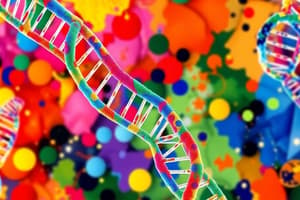Podcast
Questions and Answers
What is the primary role of the centromere in a chromosome?
What is the primary role of the centromere in a chromosome?
- To provide protection against degradation
- To store genetic information
- To facilitate the movement of the chromosome during anaphase (correct)
- To maintain chromosome structure during interphase
What do chromatids contain during cell division?
What do chromatids contain during cell division?
- Ribosomal RNA
- Mitochondrial DNA
- Non-coding RNA
- Identical copies of DNA (correct)
Which component of a chromosome is involved in controlling its size?
Which component of a chromosome is involved in controlling its size?
- Chromonema (correct)
- Matrix (Pellicle)
- Telomere
- Chromatid
What are chromomeres primarily made up of?
What are chromomeres primarily made up of?
Which part of the chromosome is associated with the organization of the nucleolus?
Which part of the chromosome is associated with the organization of the nucleolus?
Flashcards are hidden until you start studying
Study Notes
Chromosomes
- Thread-like structures found in the nucleus of plant and animal cells.
- Contain DNA, the basic genetic material passed from one generation to another.
- Humans have 23 pairs
- Chromosomes allow for the organization and transport of genetic material during cell division.
Structure
- Centromere (or Kinetochore): Primary constriction in the center of a chromosome, where spindle fibers attach.
- This is critical for the movement of chromosomes during anaphase (cell division).
- Chromatid: Each of the two identical halves of a chromosome joined by the centromere during cell division.
- Each chromatid contains DNA and is considered a separate chromosome strand.
- Chromatin: A complex of DNA, RNA, and proteins found within the nucleus of eukaryotic cells.
- This complex forms the chromosomes.
- Chromatin is important for organizing the genetic material within the nucleus.
- Secondary Constriction: Region involved in nucleolar organization.
- This constriction is present during cell division.
- Telomere: The terminal region at each end of a chromosome.
- Telomeres protect the ends of chromosomes and play a role in aging.
- Chromonema: A thread-like, coiled filament that controls the size of the chromosome.
- It contains gene-bearing chromomeres.
- Chromomeres: Bead-like structures arranged along the chromonema.
- Contain genes which are constant in number for each chromosome.
- Matrix (Pellicle): A jelly-like substance made of non-genetic material that surrounds each chromosome.
- Matrix holds the other components together.
Studying That Suits You
Use AI to generate personalized quizzes and flashcards to suit your learning preferences.




